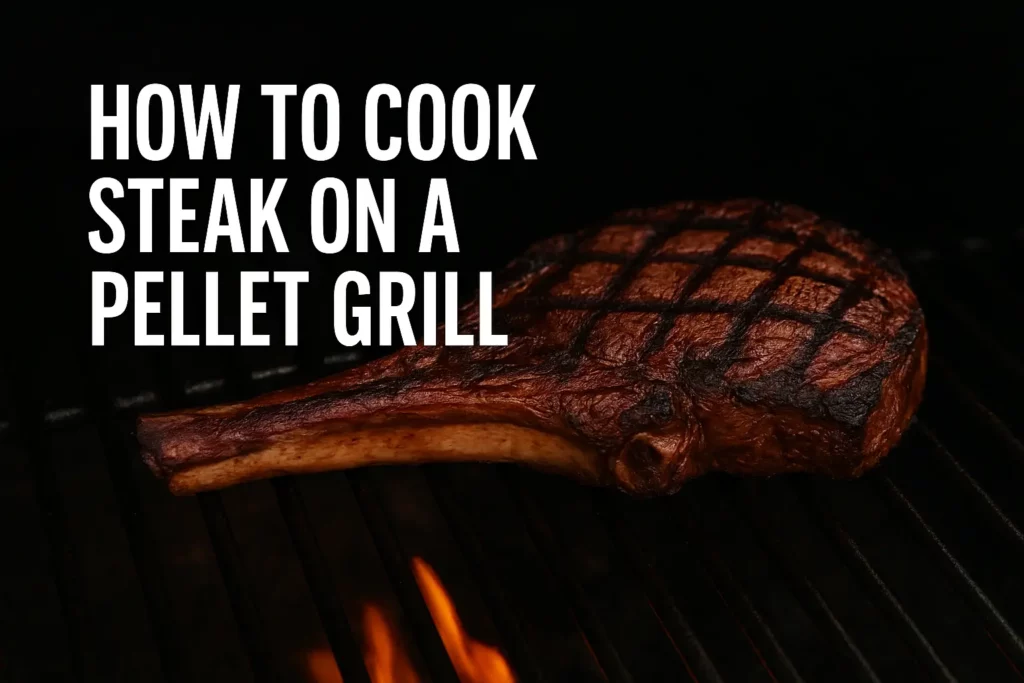This post may contain affiliate links. If you use these links to buy something we may earn a small commission. Thanks.
Grilling steak is a beloved tradition for many, and cooking on a pellet grill adds a unique flavor and texture that’s hard to beat. Pellet grills offer a convenient and efficient way to cook your steaks to perfection while infusing them with smoky flavors that enhance their taste. Whether you’re a seasoned griller or a newcomer to the pellet grill scene, this guide will walk you through the process of cooking steak on a pellet grill to ensure a tender, flavorful result every time.
Pellet grills are often hailed as the perfect marriage of convenience and flavor, combining the ease of a gas grill with the rich taste of wood-fired cooking. These grills use wood pellets as fuel, which burn slowly and create a constant temperature, giving your steak a deliciously smoky flavor. With precise temperature control and minimal effort, cooking steak on a pellet grill allows for a flawless grilling experience.
The best part about using a pellet grill for steak is the ability to easily control the temperature, ensuring that your steak cooks evenly and reaches the perfect level of doneness. Whether you’re grilling ribeye, strip steak, or filet mignon, a pellet grill can bring out the best in your cut of meat.

Preparing the Steak
1. Choosing the Right Cut of Steak
The first step in making a great steak is choosing the right cut. Different cuts offer varying levels of tenderness, flavor, and fat content. Some of the most popular cuts for grilling on a pellet grill include:
- Ribeye: Known for its marbling and rich flavor, ribeye steaks are perfect for pellet grilling. The fat in the steak melts as it cooks, resulting in a juicy, flavorful steak.
- New York Strip: Slightly leaner than ribeye, this cut still has a good amount of flavor and tenderness. It’s ideal for grilling, offering a hearty texture and robust beefy taste.
- Filet Mignon: Known for its tenderness, this cut has less fat but makes up for it with a delicate, melt-in-your-mouth texture.
- T-bone or Porterhouse: These cuts provide both the tenderloin and strip steak, making them a great option for those who enjoy variety.
When selecting your steak, look for a piece that is at least 1 to 1.5 inches thick. Thicker cuts will allow you to achieve the perfect sear on the outside while keeping the inside tender and juicy.
2. Room Temperature: Why It Matters
Before grilling, it’s important to let your steak come to room temperature. Taking the chill off the steak helps it cook more evenly and prevents it from becoming tough. Remove the steak from the refrigerator about 30-45 minutes before grilling.
3. Seasoning Options
Seasoning your steak is essential to enhancing its natural flavor. While simple salt and pepper can be enough, you can also experiment with dry rubs, marinades, or even a steak butter glaze. Here are some seasoning options:
- Salt and Pepper: The simplest and most classic approach. Generously season the steak on both sides.
- Dry Rub: A blend of spices like paprika, garlic powder, onion powder, and cayenne pepper can create a flavorful crust on the steak.
- Marinades: If you want to infuse your steak with additional flavors, marinate it in a mixture of olive oil, vinegar, herbs, and spices. Be cautious not to marinate too long, as the acids can break down the meat.
Allow the steak to absorb the seasoning for at least 15-30 minutes before grilling.
4. Let the Steak Rest
Once seasoned, let your steak rest for a few minutes before placing it on the grill. This resting period helps the seasoning penetrate the meat and allows the steak to retain moisture during cooking.
Preheating the Pellet Grill
1. Setting Up the Pellet Grill
Before cooking your steak, it’s crucial to preheat your pellet grill to the desired temperature. Pellet grills work best when the cooking temperature is steady, which is one of their key benefits over traditional charcoal grills.
Set your pellet grill to a high temperature, typically between 450-500°F. This high heat is essential for getting a good sear on your steak while ensuring it cooks through evenly. You can adjust the temperature based on the thickness of your steak and your preferred level of doneness. For thinner steaks, you might want to stick to the lower end of the temperature range.
2. Choosing the Right Wood Pellets
The type of wood pellets you use will significantly affect the flavor of your steak. Different wood types provide distinct smoky flavors:
- Hickory: Offers a strong, robust flavor that pairs well with beef.
- Oak: A versatile choice that gives a more neutral, balanced smoke.
- Mesquite: A bold, intense flavor that’s perfect for steaks but can be overpowering if used too much.
- Cherry or Apple: Provides a mild, sweet flavor that adds a subtle smokiness to your steak.
Select pellets that complement the flavor profile you want to achieve. If you’re new to pellet grilling, start with a milder flavor like oak or hickory.
3. Ensuring the Grill Reaches Desired Temperature
Once you’ve selected the right wood pellets, let the grill preheat for about 10-15 minutes. Use a grill thermometer to ensure it has reached the target temperature. You can also use a probe thermometer to monitor the internal temperature of your steak.
Cooking the Steak
1. Placing the Steak on the Grill Grates
Once the grill is preheated, it’s time to place your steak on the grates. For even cooking, it’s best to place the steak in the center of the grill, ensuring it has enough space around it for the smoke to circulate.
2. Grilling Times for Different Steak Cuts and Thickness
Cooking times will vary depending on the cut and thickness of the steak. Below is a general guide for grilling steaks on a pellet grill:
- Rare (120-130°F): 4-5 minutes per side.
- Medium Rare (130-135°F): 5-6 minutes per side.
- Medium (135-145°F): 6-7 minutes per side.
- Medium Well (145-155°F): 7-8 minutes per side.
- Well Done (155°F and above): 8-10 minutes per side.
Keep in mind that these times are estimates. The best way to ensure your steak is cooked perfectly is by using a meat thermometer. Insert the probe into the thickest part of the steak to get an accurate reading.
3. Flipping the Steak
For a perfect sear, flip the steak only once during cooking. Avoid flipping the steak multiple times, as this can cause it to lose valuable juices. For an even cook, you can also use the reverse sear method, where you cook the steak on indirect heat first and then finish with a sear on direct heat.
4. Using a Meat Thermometer
To check the doneness of your steak, always use a meat thermometer. Insert it into the thickest part of the steak, avoiding the bone (if applicable). This ensures the most accurate reading.
- Rare: 120-130°F
- Medium Rare: 130-135°F
- Medium: 135-145°F
- Medium Well: 145-155°F
- Well Done: 155°F and above
Let the steak cook until it reaches your desired internal temperature. The steak will continue to cook slightly after you remove it from the grill, so consider pulling it off when it’s 5°F lower than your target temperature.
Resting the Steak
1. Why Resting Is Important
After grilling, it’s essential to let your steak rest for at least 5-10 minutes. During this resting period, the juices inside the steak redistribute, making it more tender and juicy. Cutting into the steak immediately will cause all the juices to escape, leading to a dry result.
2. Recommended Resting Time
For the best results, allow your steak to rest for 5-10 minutes on a cutting board, loosely covered with foil. This ensures a juicy and flavorful steak when you slice into it.
Serving the Steak
1. Slicing Against the Grain
To maximize tenderness, always slice your steak against the grain. This breaks up the muscle fibers and makes each bite more tender.
2. Pairing Options
While steak is delicious on its own, it can be enhanced with sauces and sides. Consider serving your steak with:
- Steak Sauce: Classic options like béarnaise, peppercorn sauce, or chimichurri.
- Sides: Mashed potatoes, grilled vegetables, or a simple salad.
- Wine Pairing: A bold red wine, like Cabernet Sauvignon or Merlot, pairs well with most cuts of steak.
Common Mistakes to Avoid
1. Overcooking or Undercooking
One of the most common mistakes when cooking steak is not checking the internal temperature. Make sure you use a meat thermometer to ensure the steak reaches the desired doneness without overcooking.
2. Not Monitoring the Grill’s Temperature
Pellet grills maintain a steady temperature, but it’s still essential to monitor them regularly. If the temperature fluctuates too much, it can lead to uneven cooking. Always check that your grill has reached the right temperature before you start cooking.
3. Skipping the Resting Period
Resting the steak is essential for a juicy result. Avoid cutting into the steak right after grilling, as this causes the juices to escape, leading to a dry texture.
Conclusion
Cooking steak on a pellet grill is an easy and effective way to achieve a perfectly cooked, juicy, and flavorful steak every time. By selecting the right cut of meat, seasoning it properly, and following the proper grilling techniques, you can enjoy a delicious steak with minimal effort. Remember to keep an eye on the internal temperature, let the steak rest, and serve it with your favorite sides and sauces for an unforgettable meal. Happy grilling.
